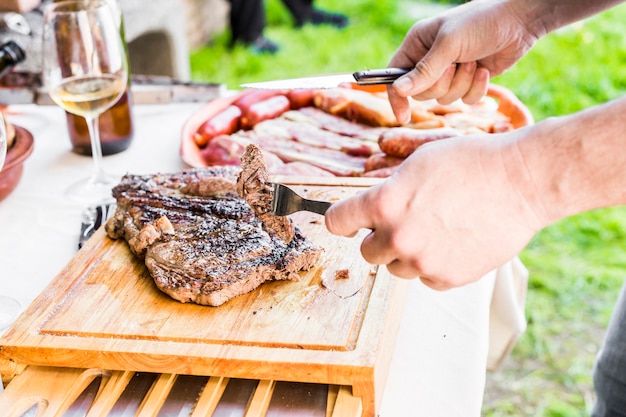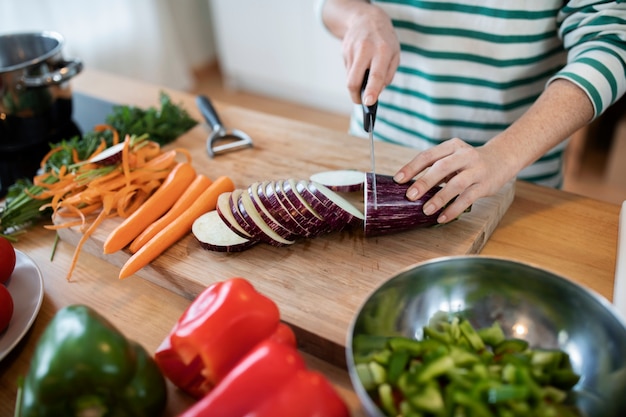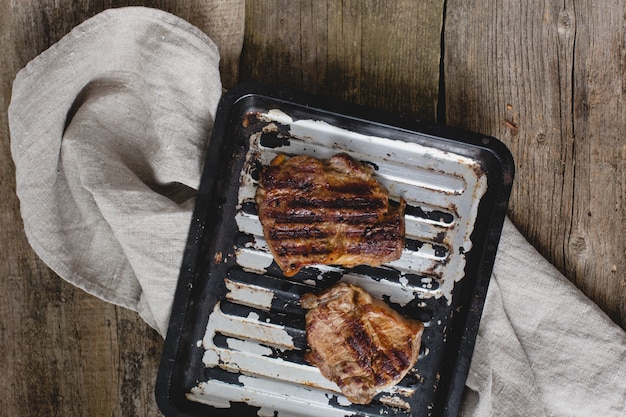Let's be honest, there's nothing quite like a perfectly cooked steak. That juicy, tender inside, the crisp, flavorful sear on the outside, and the heavenly aroma – it's a culinary masterpiece! For years, I was terrified of cooking steak, always ending up with something tough and dry. It felt like I was destined to fail every time. But then, I had a lightbulb moment! It wasn't about the grill; it was about understanding the steak itself, the different cuts, and the science behind getting it just right. That's what I'm going to share with you today. No fancy equipment, no need for a grill – just a trusty oven or pan, and you'll be on your way to steak perfection.
(Part 1) Getting to Know Your Steak

choosing the right cut
The first step is to choose the perfect cut of steak. We're aiming for something tender, juicy, and full of flavor. Here are some of my go-to choices, each with its own unique characteristics:
- Rib Eye: Ah, the rib eye! It's a classic for a reason. Rich in flavor, marbling, and melt-in-your-mouth tenderness. It's a bit pricier, but worth every penny.
- new york strip: A bit leaner than the rib eye, but still incredibly tender and delicious. Perfect for those who prefer a bit less fat, without sacrificing flavor.
- Sirloin: A bit tougher than the other two, but still a great choice for a budget-friendly steak. Just remember to cook it a bit longer to ensure it's tender. The trick is to cook it slowly and evenly, allowing the fibers to break down and become tender.
- filet mignon: This cut is the most tender, but it can be a bit more expensive. It's a great choice if you want a steak that's almost guaranteed to be cooked perfectly.
Getting the Steak Ready
Once you've chosen your steak, it's time to give it a little TLC to ensure optimal cooking results.
Pat It Dry
First things first, pat it dry with paper towels. We want a dry surface to achieve that beautiful sear.
Salt It
Now, here's where things get interesting. Salt is our secret weapon! It draws out moisture from the steak, but also adds flavor. I like to salt my steak generously and let it sit at room temperature for about 30 minutes before cooking. This lets the salt work its magic and helps the steak cook more evenly.
Season It
While you're at it, feel free to add any other seasonings you like. Black pepper is a classic, but you can also get creative with herbs like thyme, rosemary, garlic powder, or even a little paprika for a touch of color.
(Part 2) The oven method

Preheating the Oven
Okay, now for the cooking! Preheat your oven to a nice, high temperature – about 400°F (200°C). We want that oven blazing hot to create a beautiful sear on our steak.
Searing the Steak
You can sear the steak in a cast iron pan or on a baking sheet. I prefer the pan because it gives a nice, even sear. Get that pan super hot, then add a little oil. Don't be afraid to use plenty of oil – it helps to prevent sticking and makes for a crispy crust. Once the oil is shimmering, carefully place your steak in the pan. Don't move it around too much, just let it sit for about 2-3 minutes per side to get that delicious sear.
Finishing in the Oven
Now, take that beautifully seared steak and pop it in the preheated oven. The exact time will depend on the thickness of your steak and how you like it cooked, but a good rule of thumb is about 10-15 minutes for medium-rare.
Resting the Steak
Once the steak is cooked to your liking, take it out of the oven and let it rest for about 10 minutes. This is crucial! It lets the juices redistribute throughout the steak, making it even more tender and juicy.
(Part 3) The Pan Method

Heating the Pan
This method is a bit quicker and doesn't require an oven. Get that pan nice and hot – we want it screaming hot. You can use a cast iron pan or a good quality stainless steel pan. Add a little oil to the pan, just enough to coat the bottom.
Searing the Steak
Once the pan is hot, carefully place your steak in the pan. Don't move it around too much, just let it sit for about 2-3 minutes per side. You're looking for a nice, crispy crust.
Reducing the Heat
Once the steak is seared, reduce the heat to medium-low. If you’re using a cast iron pan, you can leave it on the stovetop. If you’re using a stainless steel pan, you may need to transfer it to a different burner to reduce the heat.
Cooking the Steak
Now, we're going to cook the steak to our desired doneness. Use a meat thermometer to check the internal temperature.
| Doneness | Internal Temperature (°F) | Internal Temperature (°C) |
|---|---|---|
| Rare | 125-130 | 52-54 |
| Medium-Rare | 130-135 | 54-57 |
| Medium | 140-145 | 60-63 |
| Medium-Well | 150-155 | 65-68 |
| Well-Done | 160 | 71 |
Resting the Steak
Once the steak is cooked to your liking, take it out of the pan and let it rest for about 10 minutes. This lets the juices redistribute throughout the steak, making it even more tender and juicy.
(Part 4) Mastering the Techniques
How Long to Cook
The cooking time will depend on the thickness of your steak and how you like it cooked. Here's a rough guide:
- 1-inch thick steak: About 4-5 minutes per side for medium-rare.
- 1.5-inch thick steak: About 5-6 minutes per side for medium-rare.
- 2-inch thick steak: About 6-7 minutes per side for medium-rare.
Remember, these are just guidelines. Use a meat thermometer to ensure the steak is cooked to your liking. It's better to err on the side of undercooked than overcooked.
Cooking Different Thicknesses
For thinner steaks, you might just want to sear them in a pan for a couple of minutes per side and then serve. For thicker steaks, you can use the oven method to ensure they're cooked evenly throughout.
Using a Meat Thermometer
A meat thermometer is your best friend when it comes to cooking steak. It helps you ensure the steak is cooked to your liking without overcooking it. Just insert the thermometer into the thickest part of the steak, making sure it doesn't touch the bone.
(Part 5) Taking it to the Next Level
Adding Butter
Once the steak is cooked and resting, you can add a little butter to the pan and let it melt. Then, baste the steak with the melted butter. This gives the steak an extra layer of flavor and richness.
Using Herbs and Garlic
You can also add some herbs and garlic to the butter. Thyme, rosemary, and garlic are all classic additions. Just be careful not to overpower the flavor of the steak.
Making a Pan Sauce
While the steak is resting, you can make a quick pan sauce. Just add a little wine or broth to the pan and scrape up all the delicious bits that are stuck to the bottom. Then, simmer the sauce until it reduces and thickens. Pour the sauce over the steak and enjoy!
(Part 6) Serving Your Steak
The Right Accompaniments
Now, let's talk sides. A good steak deserves good company. Here are some of my favorite accompaniments:
- Roasted vegetables: Asparagus, broccoli, or Brussels sprouts are all delicious roasted and served alongside steak. The roasting process brings out their natural sweetness and complements the savory flavors of the steak.
- mashed potatoes: Classic comfort food. I like to make mine with a little garlic and herbs, adding a touch of depth and richness to the dish.
- Salad: A refreshing salad is a great way to balance out the richness of the steak. I like a simple salad with mixed greens, cherry tomatoes, and a light vinaigrette. The acidity of the vinaigrette cuts through the richness of the steak and provides a nice contrast in flavors.
- Creamed Spinach: This is a classic side dish that pairs well with steak. The creamy texture and earthy flavor complement the steak perfectly.
- Garlic Bread: A simple yet delicious side dish that adds a touch of indulgence. The buttery garlic flavor complements the steak beautifully.
The Perfect Wine Pairing
And what about a wine pairing? I always recommend a Cabernet Sauvignon or Merlot to complement the richness of the steak. The bold, full-bodied flavors of these wines can stand up to the richness of the steak and create a harmonious balance.
(Part 7) Troubleshooting Common Steak Problems
Steak is Too Tough
If your steak is too tough, it's probably because it was overcooked. Next time, cook it for a shorter time and check the internal temperature with a meat thermometer. Remember, it's always better to err on the side of undercooked than overcooked.
Steak is Too Dry
If your steak is too dry, it's probably because it was overcooked. Next time, cook it for a shorter time and check the internal temperature with a meat thermometer. You can also try marinating the steak in advance to help keep it moist. Marinating the steak in a flavorful mixture of olive oil, vinegar, herbs, and spices will not only add flavor but also help to tenderize the meat and retain moisture.
Steak is Not Seared
If your steak is not seared, it's probably because the pan wasn't hot enough. Make sure the pan is screaming hot before adding the steak. You can also try using a cast iron pan, which tends to get hotter than other types of pans.
(Part 8) FAQs
What if I don't have a meat thermometer?
You can use the finger test to estimate the doneness of the steak. Press on the center of the steak. If it feels soft and squishy, it's rare. If it feels firm and bouncy, it's medium-rare. If it feels firm and springy, it's medium. If it feels very firm and springy, it's well-done. But remember, this is just an estimate. A meat thermometer is the best way to ensure your steak is cooked to your liking.
How do I store leftover steak?
Store leftover steak in an airtight container in the refrigerator for up to 3-4 days. You can reheat it in the microwave, oven, or on the stovetop. It's best to reheat it slowly and gently to avoid drying it out. For a delicious way to reheat steak, try pan-frying it in a little butter until it's heated through.
Can I cook steak in the slow cooker?
You can cook steak in the slow cooker, but it's not ideal for getting a nice sear. If you're going to cook steak in the slow cooker, choose a tougher cut like chuck or round. Cook it on low for 6-8 hours or on high for 3-4 hours. This will allow the tougher cuts of meat to break down and become tender. Remember, it's best to use a marinade to add flavor and moisture to the steak when cooking in a slow cooker.
How do I prevent my steak from sticking to the pan?
Make sure the pan is screaming hot before adding the steak. Use a good quality oil, like avocado oil or grapeseed oil, and make sure the steak is patted dry before cooking. Don't crowd the pan, and don't move the steak around too much while it's searing. The high heat and dry surface will help prevent sticking.
What are some good steak sauces?
There are so many delicious steak sauces out there. Some of my favorites are:
- Béarnaise sauce: Classic French sauce made with egg yolks, butter, and tarragon. It has a rich, creamy texture with a subtle tang and a hint of herbaciousness. It's a great accompaniment to any steak, especially those with a more subtle flavor.
- Peppercorn sauce: Rich and savory sauce made with cracked peppercorns, butter, and cream. It's got a kick of spice, a creamy texture, and a rich, earthy flavor. It's a perfect pairing for a steak with a strong flavor, such as a rib eye or a New York strip.
- Mushroom sauce: Hearty sauce made with mushrooms, onions, and cream. It's a classic for a reason. The rich, earthy flavor of the mushrooms complements the steak perfectly.
- Red Wine Sauce: This is a rich and flavorful sauce made with red wine, shallots, and herbs. It's a great choice for a steak with a more intense flavor, such as a rib eye or a New York strip.
- Horseradish Cream Sauce: This is a tangy and refreshing sauce made with horseradish, cream, and a touch of lemon juice. It's a great choice for a steak with a more delicate flavor, such as a filet mignon.
I hope this guide has given you the confidence to cook steak like a pro! Remember, practice makes perfect, so don't be afraid to experiment and find what works best for you. And most importantly, enjoy!
Everyone is watching

Perfect Rice Every Time: The Ultimate Guide to Cooking Rice
Cooking TipsAs a self-proclaimed foodie, I've always been a bit obsessed with rice. It's the foundation of countless cuisi...

Prime Rib Roast Cooking Time Chart: Per Pound Guide
Cooking TipsPrime rib roast. Just the name conjures images of lavish dinners, crackling fires, and hearty laughter. It’s ...

The Ultimate Guide to Cooking Asparagus: Tips, Techniques, and Recipes
Cooking TipsAsparagus. The mere mention of this spring delicacy conjures up images of vibrant green spears, crisp and burs...

Ultimate Guide to Cooking the Perfect Thanksgiving Turkey
Cooking TipsThanksgiving. Just the word conjures up images of overflowing tables laden with delicious food, the scent of r...

How Long to Bake Potatoes in the Oven (Perfect Every Time)
Cooking TipsBaked potatoes are a staple in my kitchen. They're incredibly versatile, delicious, and surprisingly easy to m...
